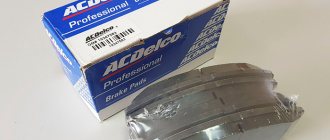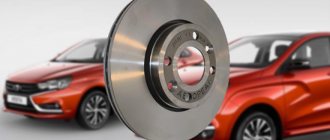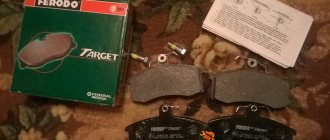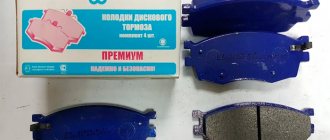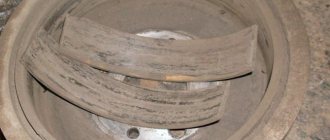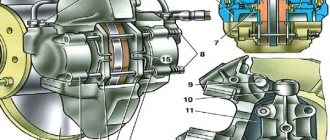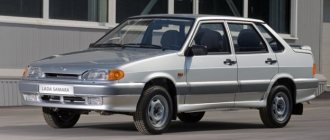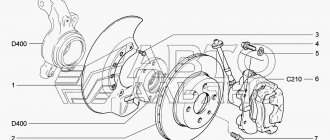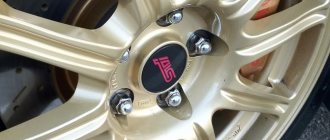The average service life of brake pads is 60-70 thousand km. Provided a moderate driving style and good quality, the service life increases by 5 - 7 thousand km.
Taking into account the wide range of spare parts and accessories for the Lada Vesta, purchasing components for an inexperienced driver becomes a real problem. What kind of pads are installed on the Lada Vesta: at the front - disc type, at the rear - drum type.
Standard pads Lada Vesta
A ventilated disc brake mechanism is installed on the front wheels of the Lada Vesta Cross St from the factory. The rear suspension is equipped with drum brakes. The exception is the “Sport” version, which comes with disc brakes. In such configurations there is no anti-lock braking system, but the discs themselves cope more effectively with the braking process. Drums are more suitable for city driving.
In the maximum configuration of Vesta, a pad wear sensor is installed, which produces a characteristic sound. Some cars have an electronic sensor that indicates wear and tear with a warning light on the dashboard.
The front pads were borrowed from the Renault Logan car. The following models are mounted from the assembly line onto the front wheels:
- with catalog article TRW 8200 432 336;
- Renault 410608481R or 8200432336;
- “TIIR” 8450108101 (Yaroslavl);
- “Lada-Sport” 8450038536.
The following are installed on the rear wheels from the factory:
- LADA 11196350208900 from the supplier “FERROVAZ” GMBH (Essen);
- 21905350208087 from the supplier “TIIR” (Yaroslavl).
It is recommended to inspect the pads on Lada Vesta every 15,00 km.
2283–14_Tormoza.indd
Front wheel brake mechanism: 1 — brake hose;
2 — hydraulic brake bleeder fitting; 3 — bolt securing the bracket to the guide pin; 4 - guide pin; 5 — protective cover of the guide pin; 6 — pad guide; 7 — caliper; 8 — brake pads; 9 — brake disc Brake mechanism of the front wheel: 1 — brake hose; 2 — hydraulic brake bleeder fitting; 3 — bolt securing the bracket to the guide pin; 4 - guide pin; 5 — protective cover of the guide pin; 6 — pad guide; 7 — caliper; 8 — brake pads; 9 — brake disc
The pads also need to be replaced when the brake disc is replaced, the linings are oily or have deep grooves, cracks and chips on them, as well as when the linings detach from the base of the pads.
We carry out the work on a flat area, inspection ditch or overpass.
Attention! The brake pads of the front wheels must be replaced only as a set - all four pads. Replacing the pads of only one brake mechanism can lead to the car pulling to the side when braking.
If the fluid level in the hydraulic brake reservoir is at the MAX mark, then before installing new pads, use a syringe or rubber bulb to pump out some of the fluid from the reservoir. This operation must be performed so that when the piston is pressed into the wheel cylinder of the brake mechanism while installing new pads, fluid does not flow out from under the reservoir cap.
We remove the front wheel and securely fix the car on a factory-made support stand. To install new pads, it is necessary to move the wheel cylinder piston as much as possible inside the cylinder.
Rating of pads for Lada Vesta
| Name | Advantage | Manufacturer | Wear indicator | Thickness | average cost |
| ATE 13.0460-2709.2 | Most Popular | Germany | – | 17.4 mm | RUB 2,029 |
| Brembo P68033 | Very reliable | Italy | + | 17.3 mm | RUB 1,839 |
| Renault 410608481R | Best price/quality ratio | France | + | 17.3 mm | RUB 1,510 |
| LYNXauto BD5739 | Most affordable | South Korea | – | 17.0 mm | 1,100 rub. |
| TRW GDB3332 | Manufacturer's recommendation | USA | – | 17.3 mm | RUB 1,847 |
TRW GDB3332
Installed on Lada Vesta from the assembly line. Heat and frequent braking do not affect the integrity of the pad and braking performance.
LYNXauto BD5739
The unique composition of the friction lining allows friction to increase when heated, without weakening braking in emergency situations. These pads fit perfectly into place, do not generate dust, and do not make noise. Their cost remains relatively cheap, and the quality is at the level of the original.
Renault 410608481R
The part is also installed from the assembly line. These pads are distinguished by their perfect fit, noiselessness, wear resistance, and last as long as stated by the manufacturer.
Brembo P68033
Pads designed for high speed travel. They are equipped with anti-squeak protection, so they remain silent even under very intense loads. The disadvantage of this model is increased wear of the brake discs. It is recommended to install a set of Brembo pads and discs.
ATE 13.0460-2709.2
Front pads for Lada Vesta with a good service life. In addition, they prevent wear of the brake discs, despite long mileage. Car enthusiasts note that these components helped solve the problem with knocking calipers. Good quality will cost more than other ATE analogues.
DSC_9461 (Copy)
Insert the blade of a slotted screwdriver into the gap between the piston and the inner brake pad.
Carefully press the piston into the cylinder to its full depth. It is important to prevent damage to the brake cylinder boot. Insert the blade of a slotted screwdriver into the gap between the piston and the inner brake pad. Carefully press the piston into the cylinder to its full depth. It is important to prevent damage to the brake cylinder boot.
Other analogues for the front suspension
| Name | Price | Buyer Experience |
| Motrio LS-KTLL | RUB 1,015 | Medium hardness |
| MILES E100108 (China) | RUB 1,208 | Low dust level, do not creak, very hard, wear out the disc |
| FERODO FDB1617 | RUB 1,895 | Creak, slight dust formation, beveled surface provides 70% pressure to the disc |
| HI-Q Sangsin Brake SP 1564 | RUB 1,285 | They squeak a lot during grinding, soft braking, no dust, a huge number of fakes |
| Blitz BB0292 | 1,200 rub. | Small resource, after 2,000 km they begin to creak, easy installation in a regular place |
| Trialli PF1402 | 865 rub. | No squeaks, good braking, little dust, easy installation in a regular place |
| TSN 2.1.212 | Approximately 300 rubles. | They creak a lot |
| UBS Performance BP11-05-007 | RUB 2,335 | Excellent braking, heavy wear at high speeds |
| REMSA 0987.00 | 1,650 rub. | Good braking, occasional squeaking |
| ASAM 30748 (Romania) | 1,000 rub. | Good braking, strong creaking, high wear resistance |
| Hagen Sangsin Brake GP 1564 | RUB 2,079 | Sometimes they squeak, good braking |
| Galfer B1G10207412 | RUB 1,920 | Excellent braking in any weather, squeaks are observed at 0 degrees and below, high wear resistance, does not wear out the discs |
| Zekkert BS-1221 (Germany) | 878 rub. | Creak in any weather, moderate hardness |
| Intelli D204E | 592 rub. | Very creaking, normal braking |
Basic faults
If we exclude the possible defective parts and poor quality from the manufacturer, then the main reason why the front pads on the Lada Vesta become unusable is wear. They actively interact with other parts of the brake mechanism, and therefore a look at the nature of damage to the friction linings will make it clear what is wrong with the operation of the brake system. By correcting this error, you will increase the service life of not only the pads, but also the entire mechanism.
The nature of the malfunctions can be noted:
- Uniform wear - it manifests itself in the fact that the friction layer is worn evenly, this shows that the brakes are working well.
- Severe wear of the friction layer, brake rivets are visible - this means that you have been using the “outdated” parts for too long. The rivets could damage the disc, so it would be a good idea to inspect it for damage.
- The friction layer is worn evenly around the entire circle, but one of the sides is worn out more than the other - one of the parts of the brake system (guide or piston) does not distribute the braking force correctly. Cleaning all “live” parts and applying a new layer of lubricant will help. Naturally, everything will have to change.
- Both components are worn unevenly, the surface is strewn with irregularities and roughness. The reason for this outcome is a malfunction of the caliper guide pins - they swing and do not give an even trajectory of movement. You will have to clean them, then reapply lubricant.
- The friction lining is cracked - in this case, the “trouble” is caused by the brake discs themselves - they wear unevenly. Everything will have to change.
- Uneven wear of the friction layer means that the parts were installed incorrectly. They will have to be changed.
After performing a visual inspection of the damage, you can independently make a verdict about the breakdown. And besides this, there are several other signs by which you can find out about a faulty front pad while sitting behind the wheel.
Creak
If a squeaking noise occurs from the front when braking, this means that the pad and disc are not mating. This happens when a cheap analogue was purchased to replace the original component. But not everything is so bad - sometimes this analogue can last a long time, but the real reason is dirt that has gotten into the moving parts and reduces the contact area of the moving parts.
Vibration at speed: what is it?
Vibration at speed appears when the pads do not fit the discs - there is some incompatibility that does not manifest itself in the operation of the “original” parts. If, when braking, you still get “full contact” of these parts of the brake mechanism, this means that the wear of the hub discs themselves is haunting, and they will have to be replaced.
Other analogues for rear suspension
| Name | Price | Buyer Experience |
| TRW GDB1384 | RUB 1,734 | Excellent braking, silent operation, no dust |
| UBS B1105007 | RUB 2,335 | Excellent braking, heavy wear at high speeds |
| Sangsin Brake SP1709 | RUB 1,690 | Soft braking, does not wear out the disc |
| Brembo P23064 (England) | RUB 1,615 | Moderately dusty, do not creak down to a temperature of -32 degrees |
| Intelli D204E | 592 rub. | Good braking, no dust, a lot of creaking |
| NISSHINBO NP2010 | RUB 1,894 | Excellent braking without squeaks |
| UBS Performance B11-05-007 | 840 rub. | No dust, squeaks with medium pedal presses, braking efficiency decreases with increasing speed |
| АDR 01131 | 350 rub. | Price/quality ratio, no squeaks, decent braking, problems with installation in a regular place, wears out the disc |
| Finwale | 925 rub. | Medium quality |
| Hankook Frixa FPE127 | RUB 1,521 | They squeak terribly (there are no anti-squeak plates), braking is good, easy installation in the original place, minimal disc wear |
| TRW GDB3332 | 1,700 rub. | Quality close to original |
| Kortech KRT1805 | 500 rub. | There is no anti-creak plate, dusty, slight creaking, excellent braking |
| Remsa 727 00 | 1,650 rub. | Good braking, no squeaking |
| Transmaster Universal TR204C | 427 rub. | Unknown manufacturer, Transmaster is only a packer, poor braking at low speeds, severe wear, cracks, deformations at high speeds |
| Ashika 5000013 | 794 rub. | Creaking after long periods of inactivity, good braking |
How to replace the pads on a Lada Vesta with your own hands, see here:
2283-14-02-06 (Copy)
... remove the guide pin from the hole in the guide block and replace the cover.
... remove the guide pin from the hole in the guide block and replace the cover.
To replace the cover of the upper guide pin, you need to unscrew the bolt of the upper fastening of the bracket to the pin and remove the bracket from the pad guide. Before installing the pin, put a little grease into the hole in the pad guide...
To replace the pads you will need the following tools:
Which pads are best to put on the vest?
- jack - a mechanism designed to lift loads standing on it, for example, a car;
- wheel bolt wrench - is a wrench suitable for working with wheel fasteners;
- slotted screwdriver - a tool for screwing or unscrewing fasteners with a straight slot, also called a “flat screwdriver”;
- A wire brush is a brush with wire bristles that will help with cleaning and removing rust. It is widely used not only in production or industry, but also at home;
- lubricant for guide pins;
- anti-squeak lubricant for the back side of the pads.
Useful and interesting A tricky way to restore and “revive” a car battery using simple home remedies
Replacement with calipers
Replacement with calipers is carried out in the same order, only at the stage when the entire mechanism is disassembled, using keys 13 and 15 you need to remove the caliper and put new parts in its place.
To replace rear disc pads on a Lada Vesta you need:
- Place the car on the ramp and lock it in gear;
- Bring the brake fluid level to a little less than half;
- Raise the rear of the machine and secure it with the support stand. Remove the wheel;
- Install the disc removal tool from the hub;
- Place the central part on the axle, and the rest will create pressure on the disk;
- If something won't come off, treat it with wd-40. Remove the bolt that secures the disc to the hub. Do this carefully, because if the edges of the bolt come off, it will be more difficult to remove;
- Remove the brake pads;
- Check the condition of the brake system. Put the new components in place and reassemble everything in reverse order;
- Bring the brake fluid level to about and adjust the brake pedal.
What can you tell by the wear of the rear brake pads?
Pad wear means:
- Wear of the friction layer;
- Damage to the friction layer (for example, cracks);
- Friction layer bevel;
- Carbon deposits on the discs or drum.
These “illnesses” can appear when:
- Light knocking sound when braking. This should not be confused with ABS;
- Poor braking efficiency;
- Whistling, grinding noise when braking;
- Dust, chips on the discs.
Any car repair operation is a treatment. But a separate operation may not be a treatment, but a concealment of the symptoms of a real disease. If consumables are changed due to their “natural death” - the mileage mark has simply reached 60,000 km, then other parts of the mechanism clearly should not be blamed for this.
But if the consumables failed earlier, then replacing them may not solve the problem, and soon you may have to change not only them, but also other parts of the mechanism. This is due to another malfunction in the mechanism:
- Insufficient brake fluid level;
- Caliper malfunction (causes uneven wear of the friction layer), insufficient amount of lubricant or unsuitable lubricant;
- Faulty guides (for example, damaged boot);
- Incorrect adjustment of the service brake system, failure to release the handbrake;
- Low quality friction layer;
- Damage to oil seals;
- Depressurization (airing) of the mechanism;
- Uneven operation of hydraulic cylinders supplying unequal forces;
- Brake hose leak;
- ABS jamming;
- Warped brake disc.
Removing and installing front pads
Before starting work, prepare the following tools:
- Keys for 13 and 15;
- Brake system parts cleaner (a regular rag will not be able to completely remove dirt and used lubricant residues);
- Flat screwdriver;
- High temperature grease.
The procedure for replacing parts is as follows:
- Secure the vehicle in place by applying the parking brake. Turn off the ignition. Raise the front of Vesta with a jack;
- Proceed to remove the wheel. Remove the cap, loosen the bolts one turn. Continue this action in a circle with all the bolts;
- Remove the brake fluid reservoir cap and pump out a few milliliters. This will prevent the liquid from coming under pressure. Press the brake cylinder inward with a screwdriver;
- Use a 15mm wrench to hold the caliper guide pin, and use a 13mm wrench to remove the two bolts. Do not let the free part of the caliper fall to the ground;
- Pry up the outer pad with a screwdriver and carefully remove it. In the same way, remove the inner block;
- The spring retainer, which is responsible for uniform wear, will have to be cleaned and then re-coated with lubricant;
- Install a new part - first the external one, then the internal one;
- Clean the guides and also coat them with lubricant;
- Put all the parts back;
- Tighten the fastening bolts, install the wheel, clockwise, one rotation at a time, secure all the bolts.
Analogues on calipers and drums
There are analogues for Lada Vesta drum brakes on the market:
- Fenox (BP53013). Cost 980 rubles; (BP53168) Price 1340 rubles;
- Hella Pagid (8DB355002-411). Price 2780 rubles;
- JP Group (1563900810). Price 1490 rubles;
- Mintex (MFR516). Price 2550 rubles;
- Patron (PSP8742). Price 730 rubles;
- Remsa (4137.00). Price 1110 rubles;
- Textar (91057300). Price 3130 rubles.
There is an analogue of Lada Vesta disc brakes. It is produced by TRW, article number gdb1384, cost – 1400 rubles.

